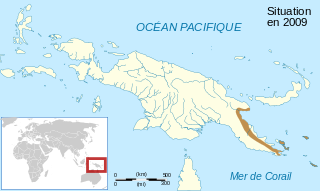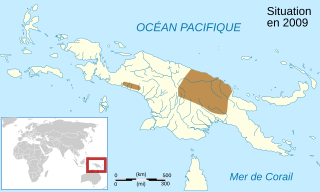
An IUCN Red List Critically Endangered species is one that has been categorized by the International Union for Conservation of Nature as facing an extremely high risk of extinction in the wild. As of December 2023, of the 157,190 species currently on the IUCN Red List, 9,760 of those are listed as Critically Endangered, with 1,302 being possibly extinct and 67 possibly extinct in the wild.
Austrochaperina aquilonia is a species of frogs in the family Microhylidae. It is endemic to the Sandaun Province, north-western Papua New Guinea. It is only known from two nearby locations in the Torricelli Mountains: Mount Somoro and from the village of Wilbeite. The specific name aquilonia is a Latin adjective meaning "northern" and refers to the range of this species in the north coast mountains of New Guinea.
Austrochaperina blumi is a species of frog in the family Microhylidae. It is endemic to New Guinea and known from the northern slopes of the New Guinean Central Range in Western New Guinea (Indonesia), and from the Bewani, Torricelli, and Hunstein Mountains in Papua New Guinea. The specific name blumi honors J. Paul Blum, the herpetologist who collected the type series. Common name Kosarek land frog has been proposed for it.
Austrochaperina brevipes is a species of frog in the family Microhylidae. It is endemic to Papua New Guinea and known only from two localities, Mount Victoria and Myola Guest House in the Owen Stanley Range. Common name Victoria land frog has been suggested for it.

Copiula derongo is a species of frog in the family Microhylidae. It is endemic to New Guinea and found in both Indonesia and Papua New Guinea. The specific name derongo refers to its type locality, the village of Derongo in the Western Province. Based on molecular evidence, it was transferred from Austrochaperina to Copiula in 2016.

Copiula guttata is a species of frog in the family Microhylidae. It is endemic to Papua New Guinea and known from around the head of the Gulf of Papua in the Gulf and Chimbu Provinces. The specific name is the Latin adjective guttata that means "spotted" and refers to the dorsal colour pattern of this species. Based on molecular evidence, it was transferred from Austrochaperina to Copiula in 2016.
Austrochaperina kosarek is a species of frog in the family Microhylidae. It is endemic to New Guinea and only known from its type locality, Kosarek, in West Papua (Indonesia). It is only known from one specimen collected in 1979. It has not been well-studied but it might be widespread in suitable habitat.

Copiula rivularis is a species of frog in the family Microhylidae. It is endemic to Papua New Guinea and known from near the Indonesian border east to the Morobe Province; it is expected to occur in the Papua province of Indonesia. The specific name comes from the Latin adjective pertaining to small brooks or streams and refers to the habitat of this species. Based on molecular evidence, it was transferred from Austrochaperina to Copiula in 2016.

Sphenophryne thomsoni, sometimes known as Thomson's toothless frog, is a species of frog in the family Microhylidae. It is endemic to Papua New Guinea and occurs in the southeastern peninsular New Guinea, Louisiade Archipelago, d'Entrecasteaux Islands, and Woodlark Island. It was formerly in its own monotypic genus Genyophryne. The specific name thomsoni honours Basil Thomson, a British intelligence officer, police officer, prison governor, colonial administrator, and writer.
Sphenophryne dentata is a species of frog in the family Microhylidae. It is endemic to Papua New Guinea. Its natural habitats are subtropical or tropical moist lowland forests and subtropical or tropical moist montane forests.
Sphenophryne rubra is a species of frog in the family Microhylidae. It is endemic to New Guinea and is only known from the Kubor and Bismarck Ranges in the New Guinea Highlands, Papua New Guinea. The habitat and ecology of this species known from very few specimens are unknown.

Sphenophryne schlaginhaufeni is a species of frog in the family Microhylidae. It is found in New Guinea.
Sphenophryne similis is a species of frog in the family Microhylidae. It is endemic to New Guinea and is only known from its type locality in the Owen Stanley Range, Northern Province, Papua New Guinea.
Copiula alpestris is a species of frog in the family Microhylidae. It is endemic to Papua New Guinea and known from the Western Highlands, Chimbu, and Eastern Highlands Provinces at elevations of 1,800–2,800 m (5,900–9,200 ft) above sea level. The specific name is a Latin adjective meaning "living in high mountains", in reference to its relatively high-altitude habitats. Based on molecular evidence, the species was transferred from Oxydactyla to Copiula in 2016.
Sphenophryne brevicrus is a species of frog in the family Microhylidae. It is endemic to West Papua, Indonesia. Its natural habitat is subtropical or tropical moist montane forests.
Sphenophryne coggeri is a species of frog in the family Microhylidae. It is endemic to New Guinea and known from two regions in Papua New Guinea, one in the Madang Province and the other in the Southern Highlands Province. The specific name coggeri honors Harold Cogger, a herpetologist from the Australian Museum.
Sphenophryne crassa is a species of frog in the family Microhylidae. It is endemic to eastern New Guinea and is known from the Mount Dayman and Mount Simpson in the Owen Stanley Range, Papua New Guinea. Common name Papua land frog has been proposed for it.
Sphenophryne stenodactyla is a species of frog in the family Microhylidae. It is endemic to Papua New Guinea and known from the New Guinea Highlands in the Western Highlands, Chimbu, Eastern Highlands Provinces at elevations between 2,490 and 4,000 m above sea level. The specific name stenodactyla is derived from the Greek words stenos meaning "narrow" and dactylos meaning "digit".

Sphenophryne cornuta is a species of frogs in the family Microhylidae. It is endemic to New Guinea where it is widespread and found both in the Western New Guinea (Indonesia) and Papua New Guinea. Common name horned land frog has been proposed for it.
Sphenophryne magnitympanum is a species of frog in the family Microhylidae. It is endemic to Papua New Guinea and only known from the vicinity of its type locality on the western slope of Mount Obree, Central Province.







